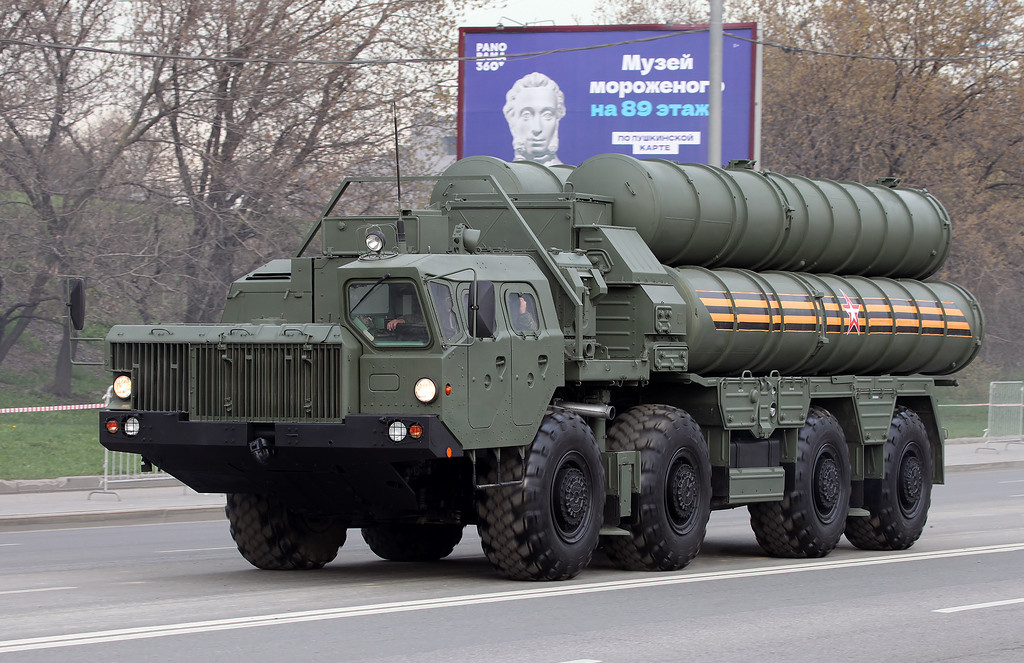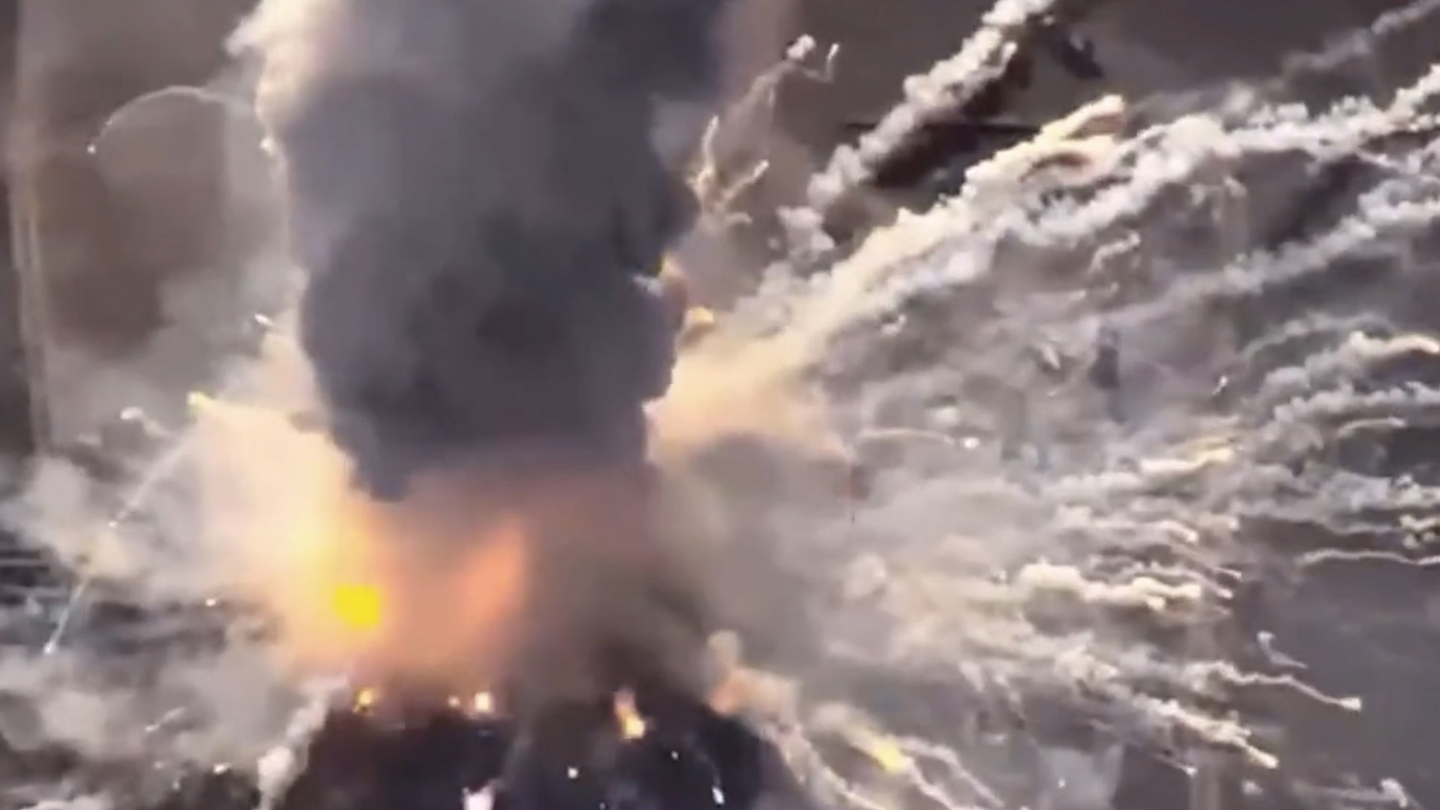A day after its boss made an ominous threat toward Russian occupation forces in Crimea, Ukraine’s Defense Intelligence Directorate says it destroyed an S-400 Triumpf surface-to-air missile system there.
The attack took place around 10 a.m. local time near the village of Olenivka on Cape Tarkhankut, the GUR announced on its Telegram channel. “As a result of the explosion, the installation itself, the missiles installed on it, and the personnel were completely destroyed.”
A video released by the GUR opens with a drone’s eye view of what it claims is the S-400 system. It then explodes in a bright yellow flash, followed by a huge column of blackish-gray smoke pouring skyward and white plumes of smoke darting out from the struck system. However, there does not seem to be any visual indication of what caused the blast.
Cape Tarkhankut is the westernmost part of the Crimean peninsula, jutting out into the Black Sea. Olenivka is about 90 miles south of the front lines in Kherson Oblast and about 115 miles southeast of Odesa. It is clearly a highly logical and strategic location for a long-range air defense battery. Taking out this battery would potentially open a hole in Russia’s air defense overlay of the peninsula and the northwestern Black Sea. This could go a long way to ensuring the survivability of standoff strike weapons, like Storm Shadow and SCALP-EG, and other attacks, such as those by long-range kamikaze drones.

Geolocated satellite imagery shows the battery about two miles north of the seaside town of Olenivka, from where images emerged of a large plume of smoke rising in the distance taken from the beach.
The long-range S-400 Triumpf is Russia’s most advanced and capable of its widely fielded air defense systems. Each self-propelled or semi-trailer-mounted launcher has four missiles, which have ranges up to 250 miles depending on the variant. That range is also highly conditions based, including the target, it’s flight profile, and many other factors. Normal engagement ranges are usually significantly less than that. Search and tracking radars, including those in the X- and L-bands, give the complete system the ability to spot and engage both short-range ballistic missiles and low-flying cruise missiles, as well as fixed and rotary-wing aircraft.

There are also reports, so far unconfirmed by any official agency, of an attack on a Russian K-300P Bastion-P coastal defense missile system that launches P-800 Oniks anti-ship cruise missiles in that same part of Crimea which we will talk more about later in this story.
The GUR did not say what weapon was used in the strike on the S-400 system, so we reached out for further details and will update this story if they are provided. The Russian Defense Ministry (MoD) has yet to say anything about the attack.
Threats From Within?
While the GUR did not offer specifics on Wednesday, the directorate’s commander, Ukrainian Maj. Gen. Kyrylo Budanov, a day earlier hinted that strikes would happen on Crimea in the coming days, and that they could involve local citizens.
He made those comments In an interview with the ITV news agency Tuesday ahead of today’s Summit of the Crimean Platform – where international leaders and organizations are attending in person and virtually to show their support for the liberation of the peninsula. Among them was U.S. Secretary of State Antony Blinken.
Budanov stated that efforts to liberate Crimea will involve “resistance in the temporarily occupied territories and the removal of occupiers from our Crimea. Our actions are apparent now, with more to come in the next few days.”
Asked by The War Zone for more details about what he meant, Budanov offered a typically cryptic response.
“We will see,” he said. “Wait.”
As we noted in our reports on drone strikes on airbases deep inside Russia over the past few days, there are increasing signs that such attacks are coming at the hands of partisans, something the GUR directly told us Monday.
“People recruited by the GUR came from central Russia, did their work and went back to their place,” GUR spokesman Andrii Yusov told The War Zone Monday when asked about its involvement in drone strikes on the Soltsy-2 and Shaykovka airbases. “GUR continues operations in Russia. In the border regions, in the deep rear and in Moscow.”
So it is possible that GUR has a network of Crimean residents who could have carried out the attack today, perhaps using drones. Or it could have been carried out by an elite Ukrainian unit operating inside Crimea. We have written about both possibilities in the past.
Russian Speculation
Meanwhile, there was rampant speculation among Russian Telegram channels about what caused the explosion. And, perhaps even more concerning to those channels, was how the Ukrainian drone that captured the explosion was able to operate with impunity over such a sensitive site.
The speculation ranged from air-launched cruise missiles to anti-ship missiles.
“The enemy publishes footage of an attack on the S-400 air defense system in the Olenivka area in Crimea this morning. What was struck is currently unknown, however, presumably, it was a [U.K.-donated] Storm Shadow cruise missile,” the Russian Grey Zone Telegram channel suggested.
“According to preliminary information, a strike on an object in Crimea this morning could have been inflicted by Harpoon anti-ship missiles from the side of Zmeiny Island [Snake Island] or other guided missile weapons,” the Russian Military Informant Telegram channel posited.
The Kremlin-connected Rybar Telegram channel also said the attack was carried out from the Black Sea “supposedly delivered by anti-ship missiles. It can be both ‘Harpoons’ and ‘Neptunes,’” which are Ukrainian-developed anti-ship missiles.
Using Harpoon or Neptune anti-ship missiles would require them to be deeply modified to carry out such a precision land strike. This is not outside the realm of possibility, nor is the idea that Ukraine has developed a land-attack variant of Neptune, but there is no evidence of this at this time. The Harpoons and Neptunes are also valuable commodities for anti-ship applications and have helped keep Russia’s Black Sea Fleet at bay. Neptune was famously used to hit the Russian Navy’s Project 1164 Slava class cruiser Moskva in the Black Sea in April, 2022. You can read more about that in our story here.
In its rationale for suggesting that anti-ship missiles were used against the S-400 system, Rybar pointed to activity that took place in the Black Sea on Monday, saying it was a precursor to today’s attack.
As we reported yesterday, the Russian Defense Ministry (MoD) claimed it destroyed two Ukrainian vessels in the Black Sea, including a U.S.-supplied Willard Sea Force high-speed patrol boat with a Ukrainian landing force attacked east of Snake Island.
The Russian MoD even posted video of that incident, claiming the vessel was destroyed.
However, today, the GUR posted a video of its own showing what it says was one of those Ukrainian vessels firing at the Russian jet with a man-portable air defense system (MANPADS). The video cuts out before any impact is seen, so we don’t really know what happened.
In addition, Russia also claimed Tuesday that it chased away two drones – an MQ-9 Reaper and a TB-2 Bayraktar – operating near Crimea yesterday, which we wrote about as well.
All those incidents, Rybar claimed Wednesday, were a lead-up to the attack on the SAM system.
All this is unlikely to be connected to this attack. But it is worth pointing out given the Ukrainian threats of further action against Crimea and the fact that the GUR said it carried out today’s attack to pave the way for future actions there.
“Given the limited number of such complexes in the enemy’s arsenal, this is a painful blow to the air defense system of the occupiers, which will have a serious impact on further events in the occupied Crimea,” the GUR said.
Airspace Protection Concerns
The Russian Telegram channels expressed a great deal of concern that Ukraine was able to operate a drone over the SAM system long enough to capture the video and relay it back.
“A Ukrainian reconnaissance UAV hung unhindered directly above the positions of the air defense system, exercising objective control,” the Russian Grey Zone Telegram channel reported. “Such incidents raise legitimate questions about the quality of air defense coverage in one of the most ‘missile-hazardous’ regions of Russia.”
“It should be noted that the enemy has the ability to fix the defeat by means of objective control over the Crimea in the ‘real time’ mode,” the Romanov Telegram channel warned.
“An extremely interesting question is, by what technical means did the enemy obtain footage of today’s attack on Crimea?” the Two Majors Telegram channel asked.
The reality is that small drones are hard to detect using traditional air defense systems, especially ones that are barely moving. Even if they can be detected, shooting them down can be even more problematic. In addition, air defenses come on and offline for maintenance and tactical reasons, they are not running constantly unless there are multiple layers of redundancies. On the other hand, a large static air defense site in such a key location should have had closer-in point defense systems to protect them from near threats. It isn’t clear if this was the case here or not. Regardless, it was ineffective if it was.
Bastion Strike Claim
In addition to the attack on the SAM system, there were unconfirmed reports that Ukraine also struck a Russian Bastion coastal missile system, known by the NATO designation SSC-5 Stooge, which launch P-800 Oniks anti-ship missiles. Those have been also used in their secondary surface-strike role for attacks on Odesa and Mykolaiv. Russia began launching those attacks from Crimea in the early phase of the invasion. You can read more about that in our story here.
The claim about the attack on the Bastion system was made on the Telegram channels of Petro Andriushchenko, advisor to the Mayor of Mariupol, and Crimean Wind, a Ukrainian outlet dedicated to news about the peninsula.
While those reports have not been officially confirmed, it would make sense to attack a weapons system that has been directly threatening Ukraine, especially if it is in the same general area as the SAM system.
Combined with attacks on bridges – like those on the Kerch Strait Bridge as well as those across the Chongar Strait – this appears to be the latest effort to hit targets inside Crimea, wear down Russian defenses there and choke off vital logistic supply routes.
With Ukraine’s counteroffensive moving slowly, and time running out before the bad weather of October sets in, making progress even harder, it remains to be seen how much all this effects Russia’s ability to defend the territory it has seized and still holds.
Undoubtedly, however, there will be more such attacks like the one today.
Contact the author: howard@thewarzone.com
